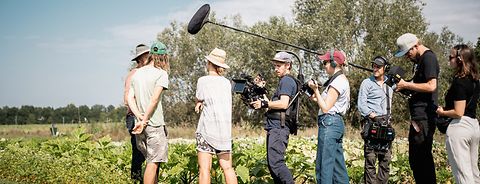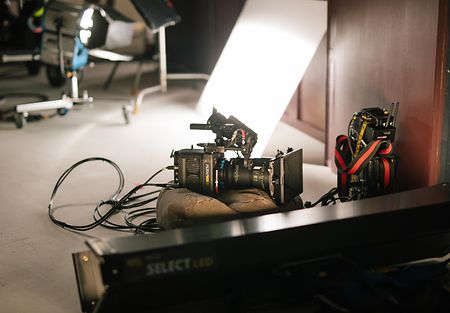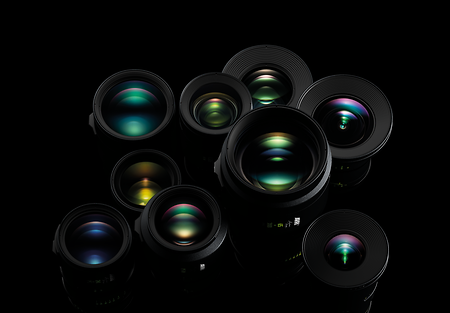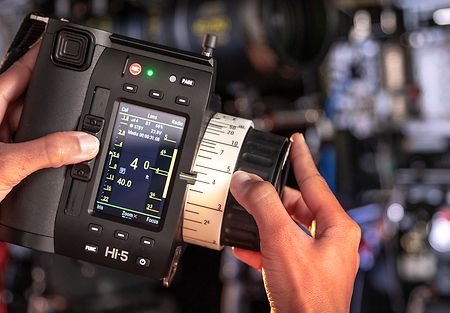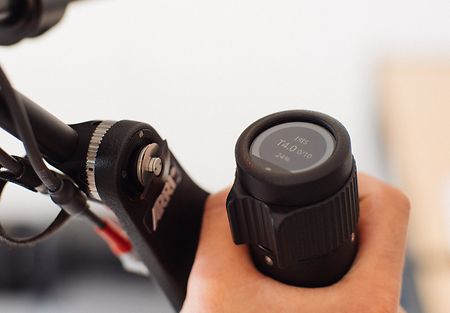Produced by megaherz and NEOS Film in Germany for Disney+, “Farm Rebellion” is a six-part documentary series about global sustainable agriculture, centering on a farm near Berlin run by former investment banker Benedikt Bösel. Cinematographer Johannes Obermaier BVK and 1st AC Georg Lanz spoke to ARRI about the compact camera package that travelled with them to Kenya, Norway, the US, and England. Having established a visual approach, Obermaier provided a style guide for the separate crews that shot additional segments in England, Chile, and Brazil. Conscious of its own carbon footprint, the production worked with a minimal crew, offset its flights, and when it needed a generator for a night shoot, used a 175 kW all-electric unit.
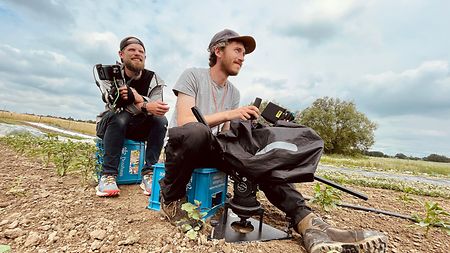
DP Johannes Obermaier BVK (center) with the ALEXA Mini LF under cover and 1st AC Georg Lanz with the Hi‑5 hand unit on location
Can you describe how the project got started and how you each became involved?
Johannes: The showrunner Martin Tischner contacted me about a year before production started. He had a first draft based on an original idea from the Executive Producer Doris Dörrie, and once I was involved, Disney—who were interested early on—asked us to shoot some trailer footage of Benedikt on his farm. They said an iPhone would be sufficient, but we wanted to shoot that trailer with real equipment to really help push the project and set a visual basis for discussion. The production company and our camera rental KLT Rental supported us very much with that idea, so I wrote the first equipment list and luckily got Georg on board.
Georg: Johannes and I have worked together for quite a few years now. He called me one day and gave me a brief overview of the project, and it sounded brilliant. Sustainable agriculture and a lot of traveling piqued my interest, and I was excited to get involved. We were an incredibly tiny team for the trailer, but it was a chance to get to know the location and try out the equipment.

Filming on the farm with investment-banker-turned-farmer Benedikt Bösel
What equipment did you use for the trailer, and did it change for the main shoot?
Johannes: We wanted to start with the ALEXA Mini LF and Signature Primes right away, so the production company got them in for the trailer. It felt a bit like a camera test, but everything went well; I found the look I was hoping for, and everybody was happy with the footage, so it was logical to not change the main setup. I think we didn’t have an onboard monitor for the test, which we did for the main shoot. I always tried to achieve a sense of flow as I moved around the protagonists, like a dance. That’s not possible without an onboard monitor because the camera is often in positions where you couldn’t put your eye to the viewfinder.
Georg: We also added the ARRI Master Grip for the main shoot. It’s an effective way to modify iris and have a trigger at the tip of your fingers without having to shift your hands. Initially we debated having the battery off-camera, but we dropped that idea because in handheld situations the cable was a restraint and slowed us down. I used a Focusbug in combination with the ARRI Hi‑5 hand unit, which was great for instances where I had to jump in a field or look at my feet and was unable to have my full attention on the scene. Other than that, we tried to reduce the setup as far as possible. We went with the minimum cage and built the camera in a super minimalistic way, without bottom plates. We could fit our entire camera kit in just six cases, and we took it around the world with us.

Prepping the ALEXA Mini LF with ARRI Master Grip for handheld shooting
Why were you so clear that large format was right for this project?
Johannes: The most important keyword from the beginning was ‘proximity’. We wanted to get as close as possible to the characters and at the same time keep their surroundings, so I knew I needed wider lenses, but on Super 35 that would quickly lead to an intrusive fisheye feel with lots of distortion. With the LF sensor we could get the matte box as close as 15 or 20 cm from our subjects and it still felt very natural. That wouldn’t have been possible with a smaller sensor. It also helped us to let the series feel a little bigger than life.
Did the different locations and climates challenge you or the equipment?
Georg: The equipment was fine. To be honest the main issue was keeping our skin from being burned in Africa, because we were right on the equator. We literally crossed the equator every morning on our way to set, and again on the way back to our hotel at the end of each day. So, not burning ourselves to death was the most challenging part! There were no technical problems; our whole setup just worked.
How big was the main crew?
Johannes: It was always three people as the main camera crew, with Georg as 1st AC, Carmen Chow as our 2nd AC and wrangler for most production days, and me as DP and operator. There were some situations where we had an additional electrician or a small lighting crew, but not many. Most of the series was shot with available light, reflectors, negative fill and diffusion, and in low key situations or on winter days we used some LED equipment. Then we always had the director, an assistant director, our sound guy, two people from the production company as helping hands, and fixer crews for filming abroad.

Handheld filming with an Easy Rig in the equatorial heat of Kenya
Was the schedule dictated by the farming calendar—things like harvests?
Georg: The timeframe was primarily dictated by the people we wanted to meet. For example, we visited Auma Obama in Kenya who has a very busy schedule, so shooting was timed around her availability. It was the same in Norway with Heidi Bjerkan, whose restaurant has a Michelin Green Star. She had tight availability but made time for us because she has one farm from which she gets most of her ingredients. So, the seasons were something we just had to deal with, and the schedule was more about the people.
You wanted a compact setup and Signature Primes are not the smallest lenses—why did you choose them?
Johannes: The Signature Primes are so lightweight that they never felt like big lenses, and almost every shot is handheld. I chose them for the proximity I mentioned and the lack of distortion, but also because I absolutely fell in love with the bokeh. The out-of-focus performance and circular bokeh was especially important in the interview situations, and it just felt right for me. They also flare less and more naturally than other lenses, and I thought it was very important to find the perfect balance between a documentary real-life look and the appearance of an advert for our common future on this planet.
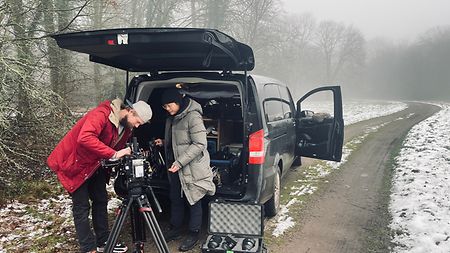
The production shot for an entire year and had to contend with winter conditions
What focal lengths were you tending to work with?
Georg: We used the 35 mm a lot of the time, and also the 47 mm. The 75 mm was our interview lens and in tiny spaces we used the 29 mm, or in rare cases the 21 mm. But those first four focal lengths were the regular setup. In situations where we were restrained or had to really strip down to a backpack setup, we left the 21 mm and 150 mm behind.
Were you trying to work to a particular T-stop?
Johannes: Most of the time we shot between T2.8 and T4. But if the light is going and you open up a Signature lens, then you really feel it’s a genuinely fast lens—maybe the fastest I’ve ever used because the widest T-stop is actually useable, whereas on other lenses it gets very soft and loses contrast. It was especially important on this project because we had an HDR deliverable, so chromatic aberration or any dip in image quality when shooting wide open would be a real problem in the color grading. I enjoyed the consistency of the Signature Primes very much. The other thing we did for night scenes was to increase the ASA on the ALEXA Mini LF to 1600, which was no problem at all, in terms of noise.
Georg—was it challenging to maintain focus working in this way?
Georg: Well, it’s always a challenge working at a 4K deliverable on a big sensor. It really helped that the Signature Primes retain contrast so well, because Johannes was often shooting against the sun, and if you have a highlight in the background a lot of lenses get very blurry; you're kind of guessing where you are, and it’s only when something blocks the sun that you can see if you nailed it. With the Signatures there was enough contrast for me to gauge focus even shooting directly against the sun, which is important when you’re moving and running around. I feel like we had a very good rhythm to the way we worked. I could anticipate Johannes’ movements, and over the course of the year I learned to do the same with our protagonists as well: which person moves back when they laugh, or how they get up from a chair.
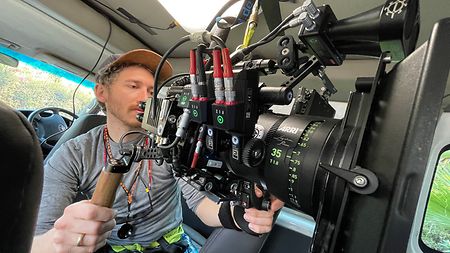
DP Johannes Obermaier BVK shooting car interiors with the 35 mm Signature Prime
What were the biggest takeaways of the shoot for you personally?
Johannes: I really enjoyed getting into the world of sustainable agriculture through the eyes of our amazing protagonists, since our goal was to be close to them. It was a perfect access route into that world for me and it changed my view on agriculture completely. The fact that a lot of shots from our teaser trailer made it into the final series shows that we had the right instincts from the beginning, and the approach continued to feel right until the end. That was very rewarding.
Georg: For me, growing up in the city and having no contact with agriculture whatsoever, it was a very educational experience. I learned a lot and it was nice to bring a few things back into my private life. The beauty of documentary is that you go where interesting things are happening. On a technical level it was fun to develop a setup that was lightweight enough to fly everywhere with us, and compact enough to load in a single car. It allowed us to be agile and to work at the speed that things were actually happening.

DP Johannes Obermaier BVK (right) with the ALEXA Mini LF and 1st AC Georg Lanz with the Hi‑5 hand unit on location
“Farm Rebellion” is currently available for streaming exclusively on Disney+
Watch the trailer here.
